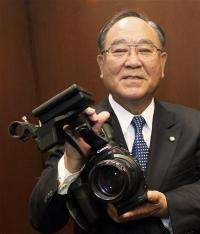Canon offers new camera for Hollywood filmmakers

(AP) -- Four decades after winning Academy Awards for its cinema lenses, Canon Inc. was back in Hollywood on Thursday, unveiling a new high-end digital video camera before an audience of some of the world's most famous filmmakers.
Fujio Mitarai, chief executive of the Japanese camera and office equipment giant, took the wraps of the movie camera, called Cinema EOS, in a packed theater on the Paramount Pictures movie studio lot.
At $20,000 for the body alone, the Cinema EOS is not cheap by consumer standards but is on the low end of what professional digital film cameras cost, which can reach into the six figures. Two zoom lenses intended for movie making will go for $45,000 and $47,000.
Making such costly cameras for professional users is somewhat of a departure for Canon, which makes up more than a third of its revenue from consumer electronics, and more than half from office equipment like all-in-one printer-copier-fax machines.
In an interview with The Associated Press, Mitarai said Canon's move into expensive high-end products for professionals comes in response to the rising yen and the movement of manufacturing to cheaper-labor countries abroad.
"Anything without high added value is now being manufactured in southeast Asian countries and China. So we need to shift into an era where all our products have an added value," Mitarai said. "That is one major trend in meeting the difficulties posed by the strong yen."
The camera draws on the popularity of the Canon EOS 5D Mark II, a single-lens reflex still camera that the company introduced in 2008 and which became widely embraced by independent filmmakers because of its ability to take full high-definition video at the 1920-by-1080 pixel resolution known as 1080p.
It didn't take long for its popularity to reach Hollywood.
The Mark II was used in the final episode of the last season of Fox's television show "House M.D.," as well as in the car racing scenes of "Iron Man 2" and certain scenes in "Captain America: The First Avenger," movies that Paramount distributed.
The Cinema EOS is similar in shape to a traditional still camera but works with a variety of mounts.
Mitarai said the camera's digital images had the warmth of film and brought out skin tones well. The company showed a number of short films that used the camera to show off how it functioned in action sequences, especially in tight areas that made use of its compact size.
The camera is compatible with an array of around 60 "EF," or electronic focus, lenses that work with Canon's still cameras. The company also introduced seven new lenses that are precise enough to work with super high-definition movie cameras made by other companies using a standard known as 4K.
"This is the camera that gave us the opportunity to work with you today," Mitarai told the crowd.
Filmmakers including Jon Favreau, Ron Howard and Martin Scorcese were in attendance.
"Mr. Mitarai, welcome to Hollywood," Scorcese said.
©2011 The Associated Press. All rights reserved. This material may not be published, broadcast, rewritten or redistributed.

















